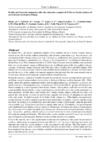Identificador persistente para citar o vincular este elemento:
https://accedacris.ulpgc.es/jspui/handle/10553/114755
| Título: | Benthic and demersal communities after the submarine eruption of El Hierro: Spatial patterns of survival and colonization of fauna | Autores/as: | Rueda, J.L. Gallardo, H. Luque, V. López, F.J. López González, N. Fernández Salas, L.M. Díaz del Río, V. Santana Casiano, Juana Magdalena Fraile Nuez,Eugenio Vázquez, J.T. |
Clasificación UNESCO: | 250621 Vulcanología 251001 Oceanografía biológica 251002 Oceanografía química |
Fecha de publicación: | 2014 | Conferencia: | IV Congress of Marine Sciences | Resumen: | In October 2011, the shallow submarine eruption of the southern part of El Hierro (Canary Islands) caused severe effects in the seafloor morphology and substrate composition (e.g. lava extrussion and construction of the volcanic edifice), the water column (e.g. acidification, deoxygenation and fertilization) and the biological communities (e.g. changes in the composition and functioning of communities) (Fraile Nuez et al. 2012; Santana Casiano et al. 2013). Due to this natural event, habitats and associated biota have experimented changes at different levels and in different parts of this new seafloor volcanic structure. Underwater images obtained with VOR Aphia 2012 (October 2013) and ROV Liropus 2000 (March 2014) as well as samples collected with a benthic dredge in March and October 2013 have made possible the study of the benthic and demersal organisms that persisted after this acute natural event as well as those that are recolonizing the recently formed volcanic bottoms. During the eruption, material of variable size and texture buried previous existing habitats and associated biota, except in certain bathyal bottoms close to the base of this new seafloor structure (200 - 500 m depth) where slow-growing suspension-feeders such as antipatharians (e.g. Stichopathes cf. gracilis, Antipathes furcata), small gorgonians (e.g. Acanthogorgia, Bebryce) and lithistid sponges still increase the bottom complexity when compared to those buried bottoms. Among them, small colonies of cold-water corals (probably Dendrophyllia cornigera and Cladocora debilis) also occur, but mostly represented by dead specimens. In both March and October 2013, benthic dredge samples collected lava rocks and gravels that were poorly colonized by invertebrates, together with remains of antipatharians and dead cold-water corals. In shallower parts of the flanks of the volcano (ca. 200m depth), most previously existing habitats formed by antipatharians have been buried after the eruptive processes and the recent lava rocks are starting to be colonized by small and scarce colonies of hydrozoans, serpulids and small size echinoids (e.g. Coelopleurus floridianus), among other species. Nevertheless, the gravel bottoms at this bathimetric level display a higher degree of colonization, with higher abundances of polychaetes (e.g. Glyceridae, Polynoidae), decapods (e.g. Alpheus spp., Heterocrypta maltzami) and some molluscs (e.g. Nassaridae), probably linked to previous succesful recruitment events or horizontal movements from adjacent unimpacted bottoms. The fish Anthias anthias and the decapod P. narval are two of the top dominant demersal organisms that have recolonized this area after the eruption. Close to the summit, one of the top-dominant sessile macroinvertebrates is the oyster Neopycnodonte cochlear, which occurs at densities of more than 100 indiv. m−2 in some of the large lava rocks and represent one of the first sessile colonizers of the lava erupted by the vulcano. This filter feeder is also very abundant on black-corals and undisturbed hard substrates located nearby at similar depths and may have benefited from the new micro-habitats available in the hard bottoms formed and the fertilization process after the eruptive event. In general, a pattern of decreasing species richness of benthic-demersal organisms has been found from close to the summit to the base of the volcano, where the low colonization rate is a result of the lower number of potential species that are able to recolonize these substrates, the specific biological features of these species (e.g. slow growth rates, small reproductive outputs) and the oligotrophic character of the water masses when compared to the summit. The findings highlight that the volcanic eruption firstly buried most previously existing habitats and later on created a highly unstable and corrosive environment that affected some slow-growing organisms (e.g. cold-water corals) but not others (e.g. antipatharians). Nevertheless, the eruption provided nutrients that are important for primary pelagic production that may have also promoted the establishment of dense populations of some sessile suspension feeders (e.g. N. cochlear, hydrozoans) in the newly formed hard substrates. | URI: | https://accedacris.ulpgc.es/handle/10553/114755 | ISBN: | 84-697-0471-0 | Fuente: | Book of Abstracts submitted to the IV Congress of Marine Sciences. Las Palmas de Gran Canaria, June 11th to 13th 2014, p.p. 378-379 |
| Colección: | Póster de congreso |
Visitas
103
actualizado el 01-nov-2024
Descargas
16
actualizado el 01-nov-2024
Google ScholarTM
Verifica
Altmetric
Comparte
Exporta metadatos
Los elementos en ULPGC accedaCRIS están protegidos por derechos de autor con todos los derechos reservados, a menos que se indique lo contrario.
